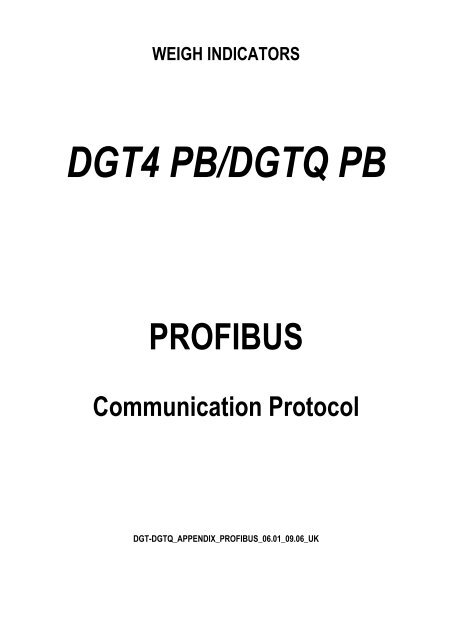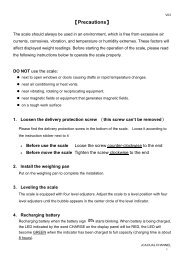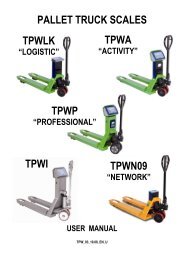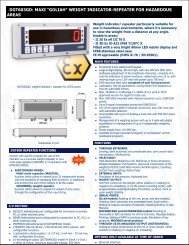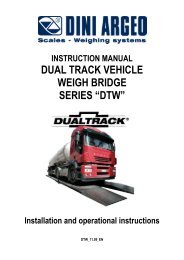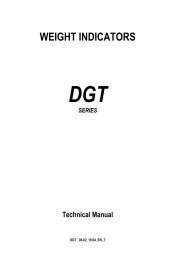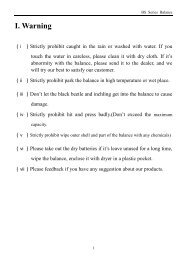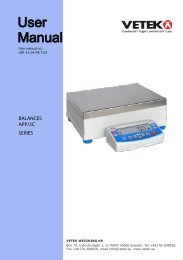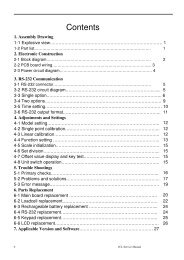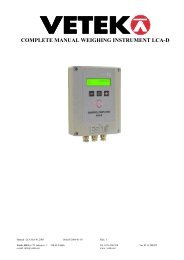You also want an ePaper? Increase the reach of your titles
YUMPU automatically turns print PDFs into web optimized ePapers that Google loves.
WEIGH INDICATORS<strong>DGT4</strong> <strong>PB</strong>/<strong>DGTQ</strong> <strong>PB</strong>PROFIBUSCommunication ProtocolDGT-<strong>DGTQ</strong>_APPENDIX_PROFIBUS_06.01_09.06_UK
INDEX<strong>DGT4</strong> <strong>PB</strong>/<strong>DGTQ</strong> <strong>PB</strong>1. Generalities..........................................................................................................................31.1 Selection of the PROFIBUS serial communication mode .................................................31.2 Communication parameters between the indicator and the Profibus: Baud Rate and DataFormat....................................................................................................................................42. Input and Output data areas ...............................................................................................42.1 INPUT DATA AREA .........................................................................................................42.1.1 Input Status Register (Table 2.1.1) (if Type >> “Ind.Ch” or “DEP.Ch”).......................62.1.2 Output Status Register (Table 2.1.2) .........................................................................72.1.3 Command Status Register .........................................................................................82.2 Output Data Area .............................................................................................................82.2.1 Command Register ....................................................................................................92.3 SET-UP area..................................................................................................................123. The GSD file structure.......................................................................................................172
<strong>DGT4</strong> <strong>PB</strong>/<strong>DGTQ</strong> <strong>PB</strong>1. GeneralitiesThe Profibus communication protocol defines the structure of the messages and the communication modebetween one or more “master” devices which manage the system and one or more “slave” devices whichrespond to the interrogations of a master (technical master-slave, of the multi-master type).The masters, called also active devices, define the data traffic on the bus and periodically scan the slaves;when a master has an access permit (token), it can transmit data without external requests. The slaves,defined also as passive devices, do not have the access permit to the bus, but can only either confirm thereceived messages or transmit messages when requested by a master.A master can either address single slaves or transmit a broadcast message to all (in the multi-master caseeach slave is linked to a master).1.1 Selection of the PROFIBUS serial communication modeTo select the Profibus communication protocol one should enter the SET-UP ENVIRONMENT of theinstrument (see Figure 1):Input in the Set-up Environment• Turn on the indicator, press the ZERO key or the TARE key during the countdown (the display shows the“tYPE” menu).• Select “SEtuP” (using the ZERO or TARE keys) press PRINT to confirm the step.• Select “SEriAL” (using the ZERO or TARE keys) press PRINT to confirm the step.• Select “Pc.SEL” (using the ZERO or TARE keys) press PRINT to enter in theSelection menu of the PC port Select “485” with <strong>DGT4</strong><strong>PB</strong> indicator or “COM1” with <strong>DGTQ</strong><strong>PB</strong> indicator and press PRINT to confirm.• Select “CoM.PC” (using the ZERO or TARE keys) press PRINT to enter in the:Set-up menu of the Communication Parameters of the PC port: The “PCMode” item appears press PRINT to enter in this submenu and select the “Profibus” item press PRINT again to confirm.Now the setting of the instrument’s serial address is requested.Instrument serial address for a few instants the “Pro.Add” message is displayed then type the serial address of theinstrument (or slave) confirm the entered value with PRINT.• Press various times the C key until the message “SAVE?” appears on the display.• Press PRINT to confirm the changes made or another key for not saving.CAREFUL: If the address is not saved it may be necessary to remove the power supply and turn back on theinstrument.3
<strong>DGT4</strong> <strong>PB</strong>/<strong>DGTQ</strong> <strong>PB</strong>1.2 Communication parameters between the indicator and the Profibus: BaudRate and Data FormatThe communication speed (baud rate) and the serial word format, between the indicator and the Profibus , arenot modifiable in the SET-UP ENVIRONMENT, but by default are set at: Baud Rate (or transmission speed): 9600 bit / sec Data Format (or serial word format): n - 8 - 1 (no parity – 8 data bits – 1 stop bit)SEtuPSEriALCoM.PCPCModEFigure 1: Selection from the SET-UP ENVIRONMENT of the MODBUS communication.ondE, rEPE.4, rEPE.6, Prin.St,Prin.EX, 485, ModbuS, Profibus,ALL.Std, ALL.Ext, StAb.St, StAb.EXPro . Add2 digits( one blinking )Figure 2: Setting the instrument’s serial address (or slave).2. Input and Output data areasThere are two data areas, an input and an output one, defined in this way due to the master’s point of view:while the input area is read by this device, the output one is written.Both the areas are organised in registers (input and output ones), on which the Profibus protocol functionsoperate.All the numeric values have the Big Endian format (the 1st byte is the most significant one) for the Input DataArea and the Output Data Area, while these have the Little Endian format (the 1st byte is the least significantone) for the SET-UP area.2.1 INPUT DATA AREAThe input data area is read by the master (is therefore read by the instrument) and is made up of 16 registers,each of 2 bytes (32 bytes overall).Table 1: Input Data Area (if Type >> “Ind.Ch” or “DEP.Ch”)N°Reg. Input Registers N° bytes0 Gross Weight Value (byte 3) 0Gross Weight Value (byte 2) 11 Gross Weight Value (byte 1) 2Gross Weight Value (byte 0) 32 Net Weight Value (byte 3) 4Net Weight Value (byte 2) 53 Net Weight Value (byte 1) 6Net Weight Value (byte 0) 74 Input Status Register (MSB) 84
Input Status Register (LSB) 95 Command Status Register (MSB) 10Command Status Register (LSB) 116 Output Status Register (MSB) 12Output Status Register (LSB) 137 N°last page read or written (MSB) 14N°last page read or written (LSB) 158 1st set-up page word 1617_ _ _ _ _ _ _ _ _ _ _ _ _ _ _ _<strong>DGT4</strong> <strong>PB</strong>/<strong>DGTQ</strong> <strong>PB</strong>15 8th set-up page word 3031Table 2: Input Data Area (if TypE >> “TrAnSM”)N°Reg. Input Registers N° bytes0 Channel 1 Status Register (MSB) 0Channel 1 Status Register (LSB) 11 Channel 2 Status Register (MSB) 2Channel 2 Status Register (LSB) 32 Channel 3 Status Register (MSB) 4Channel 3 Status Register (LSB) 53 Channel 4 Status Register (MSB) 6Channel 4 Status Register (LSB) 74 Input Status Register (MSB) 8Input Status Register (LSB) 95 Command Status Register (MSB) 10Command Status Register (LSB) 116 Output Status Register (MSB) 12Output Status Register (LSB) 137 N°last page read or written (MSB) 14N°last page read or written (LSB) 158 1st set-up page word 1617_ _ _ _ _ _ _ _ _ _ _ _ _ _ _ _15 8th set-up page word 3031NOTE: GROSS WEIGHT and NET WEIGHT value format (0-3 registers)Whole in absolute value (without decimals)Example: if 3 decimals are set, the 3,000 value is read 3000If 2 decimals are set, the 3,00 value is read 3005
Channel Status Register<strong>DGT4</strong> <strong>PB</strong>/<strong>DGTQ</strong> <strong>PB</strong>Bit Description Bit Meaning0 1(LSB)0 Weight Polarity + --1 Weight Stability NO YES2 Underload Condition NO YES3 Overload Condition NO YES4 Gross weight zone Out of Zone 0 In Zone 05 Not used6 Not used7 Not used(MSB)8 Not used9 Not used10 Not used11 Not used12 Not used13 Not used14 Not used15 Not used2.1.1 Input Status Register (Table 2.1.1) (if Type >> “Ind.Ch” or “DEP.Ch”)It is the input register number 4; two bytes defined in the following manner:Bit Description Bit Meaning0 1(LSB)0 Net Weight Polarity + --1 Gross Weight Polarity + --2 Weight Stability NO YES3 Underload Condition NO YES4 Overload Condition NO YES5 Entered Tare Condition NO YES6 Manual Tare Condition NO YES7 Gross ZERO zone Out of Zone 0 In Zone 0(MSB)8 Input 1 DISABLED ENABLED9 Input 2 DISABLED ENABLED10 Not used11 Not used12 Not used13 Not used14 Displayed Channel (low bit) ( 1 )15 Displayed Channel (high bit)(from 0 to 3) ( 1 )6
Input Status Register (if TypE >> “TrAnSM”)It is the input register number 4; two bytes defined in the following manner:<strong>DGT4</strong> <strong>PB</strong>/<strong>DGTQ</strong> <strong>PB</strong>Bit Description Bit Meaning0 1(LSB)0 Not used1 Not used2 Not used3 Not used4 Not used5 Not used6 Not used7 Not used(MSB)8 Input 1 DISABLED ENABLED9 Input 2 DISABLED ENABLED10 Not used11 Not used12 Not used13 Not used14 Displayed Channel (low bit) ( 1 )15 Displayed Channel (high bit)(from 0 to 3) ( 1 )( 1 ) : High bit, Low Bit: 0 0 → Channel 1 0 1 → Channel 2(15) (14) 1 0 → Channel 3 1 1 → Channel 42.1.2 Output Status Register (Table 2.1.2)It is input register number 6; two bytes defined in the following way:Bit Description Bit meaning0 1(LSB)0 RELAY 1 NOT EXCITED EXCITED1 RELAY 2 NOT EXCITED EXCITED2 Not used3 Not used4 Not used5 Not used6 Not used7 Not used(MSB)8 Not used9 Not used10 Not used11 Not used12 Not used13 Not used14 Not used15 Not used7
2.1.3 Command Status RegisterIt is input register number 5; two bytes defined in the following way:High Byte → Last command received (see Table 2.2.1)Low Byte: low nibble → Counting of processed commands (module 16)high nibble → Result of last command received<strong>DGT4</strong> <strong>PB</strong>/<strong>DGTQ</strong> <strong>PB</strong>In which Result of last command received can take on the following values: OK = 0 Correct command and carried out ExceptionCommandWrong = 1 Wrong command ExceptionCommandData = 2 Wrong data in the command ExceptionCommandNotAllowed = 3 Not allowed command ExceptionNoCommand = 4 Inexistent command2.2 Output Data AreaThe output data area is written by the master (is therefore read by the instrument) and is made up of 16registers, each of 2 bytes (32 bytes overall).Tabella 2: Output Data AreaReg. Nr. Output Registers N° bytes0 Command Register (MSB) 0Command Register (LSB) 11 Parameter 1 (byte 3) 2Parameter 1 (byte 2) 32 Parameter 1 (byte 1) 4Parameter 1 (byte 0) 53 Parameter 2 (byte 3) 6Parameter 2 (byte 2) 74 Parameter 2 (byte 1) 8Parameter 2 (byte 0) 95 Not used 10Not used 116 Not used 12Not used 137 Not used 14Not used 158 1st set-up page word 1617_ _ _ _ _ _ _ _ _ _ _ _ _ _ _ _15 8th set-up page word 30318
9<strong>DGT4</strong> <strong>PB</strong>/<strong>DGTQ</strong> <strong>PB</strong>2.2.1 Command RegisterIt is the output register number 0. It is made up of two bytes and can take on the following values, whichcorrespond to the implemented commands described in the table.Execution of a CommandThe execution of a command is made when the contents of the Command Register vary (therefore in order torepeat the last command one should first set the Command register to the NO COMMAND value, and then tothe command value).The only exceptions are the READ_SETUP, WRITE_SETUP and CHANGE_PAGE commands, which areexecuted even upon just the varying of Parameter 1 (page nr. to be read/written). Therefore:To read various set-up pages one just needs to set the READ_SETUP command with the first page that oneintends to write in Param.1, then change each time Param.1 with the new page nr. to be read.To write various pages one should set the WRITE_SETUP command with the nr. of the first page to be writtenin Param.1 and the data in registers 8-15 of the output area; then each time one varies the data of theregisters 8-15 and the page nr. in Param.1.Table 2.2.1: Command RegisterImplemented Command Command Register DescriptionValueNO_COMMAND 0 (0000 Hex) NO COMMANDZERO_REQUEST 1 (0001 Hex) ZERO SCALE execution (*)TARE_REQUEST 2 (0002 Hex) AUTOMATIC TARE execution (*)TAREMAN_REQUEST 3 (0003 Hex) MANUAL TARE execution (*)(the value will be entered in Parameter 1 ( 2 ))NET_SWITCH_REQUEST 4 (0004 Hex) Display Switch on the NET WEIGHT ( 3 ) (*)GROSS_SWITCH_REQUEST 5 (0005 Hex) Display Switch on the GROSS WEIGHT ( 3 ) (*)CHANNEL_1_REQUEST 6 (0006 Hex) Switching on CHANNEL 1CHANNEL_2_REQUEST 7 (0007 Hex) Switching on CHANNEL 2CHANNEL_3_REQUEST 8 (0008 Hex) Switching on CHANNEL 3CHANNEL_4_REQUEST 9 (0009 Hex) Switching on CHANNEL 4WRITE_SETPOINT_1 10 (000A Hex) SETPOINT 1 writing(ON value in Param. 1; OFF value in Param. 2) ( 2 )WRITE_SETPOINT_2 11 (000B Hex) SETPOINT 2 writing(ON value in Param. 1; OFF value in Param. 2) ( 2 )WRITE_SETPOINT_3 12 (000A Hex) SETPOINT 3 writing(ON value in Param. 1; OFF value in Param. 2) ( 2 )WRITE_SETPOINT_4 13 (000B Hex) SETPOINT 4 writing(ON value in Param. 1; OFF value in Param. 2) ( 2 )WRITE_SETPOINT_5 14 (000A Hex) SETPOINT 5 writing(ON value in Param. 1; OFF value in Param. 2) ( 2 )WRITE_SETPOINT_6 15 (000B Hex) SETPOINT 6 writing(ON value in Param. 1; OFF value in Param. 2) ( 2 )SET_OUTPUT 25 (0019 Hex) Setting the RELAY ( 4 )READ_SETUP 26 (001A Hex) SET-UP PAGE READINGWRITE_SETUP 27 (001B Hex) SET-UP PAGE WRITINGWRITE_FLASH 28 (001C Hex) SAVING THE SET-UP in FLASHCHANGE_PAGE 29 (001D Hex) ALIBI PAGE ( 5 ) or TRANSM PAGE ( 7 )READ_ALIBI 30 (001E Hex) WEIGH READING ON ALIBI ( 6 )WRITE_ALIBI 31 (001F Hex) STORAGE OF WEIGH ON ALIBI ( 5 )(*) This command is not managed in the “TRANSM” mode.
( 2 ) NOTE: Value format of Parameter 1 and Parameter 2:→ For the MANUAL TARE (only Param1):→ For SETPOINTS 1and 2:Whole in absolute value (without decimals)<strong>DGT4</strong> <strong>PB</strong>/<strong>DGTQ</strong> <strong>PB</strong>Example: If 3 decimals are set, in order to enter the value 3,000 → one should write 3000If 2 decimals are set, in order to enter the value 3,00 → one should write 300( 3 ) : active functions only in NTGS mode (net / gross switch).( 4 ) Setting of the RELAYSThe status of the relays is settable using Parameter 1:Parameter 1:bit 0 → RELAY 1in which bit 0 = 1 → RELAY 1 CLOSED; bit 0 = 0 → RELAY 1 OPENbit 1 → RELAY 2in which bit 1 = 1 → RELAY 2 CLOSED; bit 1 = 0 → RELAY 2 OPENOPTIONAL RELAYS (ONLY <strong>DGTQ</strong> <strong>PB</strong>)bit 2 → RELAY 3in which bit 2 = 1 → RELAY 3 CLOSED; bit 2 = 0 → RELAY 3 OPENbit 3 → RELAY 4in which bit 3 = 1 → RELAY 4 CLOSED; bit 3 = 0 → RELAY 4 OPENbit 4 → RELAY 5in which bit 4 = 1 → RELAY 5 CLOSED; bit 4 = 0 → RELAY 5 OPENbit 5 → RELAY 6in which bit 5 = 1 → RELAY 6 CLOSED; bit 5 = 0 → RELAY 6 OPENbit 6 ÷15 (not used)NOTES: Value format of Parameter 1 and Parameter 2 for the RELAYS:→ Bit configurationIn the case a relay is linked to a setpoint, the command, relative to that relay, is ignored. The writing of the setpoint values does not cause the automatic flash saving, but are set temporarily. Inorder to save these in flash one should execute the WRITE_FLASH command.( 5 ) ALIBI PAGETo go to the ALIBI page set the value 1000 in Parameter 1. With the writing command, if one wants to fill thepage with the values described in the table below, one must first use this command and then transmit thewriting command.Format of the Parameter 1 value:Whole in absolute value (without decimals)10
Table 2.2.1.1: CONTENTS OF ALIBI PAGE<strong>DGT4</strong> <strong>PB</strong>/<strong>DGTQ</strong> <strong>PB</strong>ALIBI PAGE(16 bytes)Input Data Area Description(N° Byte)16 Stored gross weight value (byte 3)17 Stored gross weight value (byte 2)18 Stored gross weight value (byte 1)19 Stored gross weight value (byte 0)20 Stored tare weight value (byte 3)21 Stored tare weight value (byte 2)22 Stored tare weight value (byte 1)23 Stored tare weight value (byte 0)24 ID: Weigh number (byte 3)25 ID: Weigh number (byte 2)26 ID: Weigh number (byte 1)27 ID: Weigh number (byte 0)28 Alibi status register (MSB)29 Alibi status register (LSB)30 Not used31 Not used Format of the Alibi status register value:2 bytes defined in the following way:BITMEANING-------------------------------------------------------------------------------------------------------------------------------------bit from 7 to 0 → Number of rewritings (from 0 to 255).bit from 10 to 8 → Number of scale (from 1 to 4).bit 11 → Type of tare; bit 11 = 1 → manual tare; bit 1 = 0 → null or semiautomatic tarebit 12 → Not usedbit 13 → Not usedbit 14 → Not usedbit 15 → Not used( 6 ) WEIGH READING ON ALIBITo read a weigh stored in the ALIBI set the rewriting number in Parameter 1 and the weigh number (ID) inParameter 2. The command automatically executes the change on the ALIBI page: see table 2.2.1.1.Format of the Parameter 1 and Parameter 2 values:Whole in absolute value (without decimals)( 7 ) TRANSM PAGE (only if TYPE >> TRANSM)To go to the TRANSM page set the value 2000 in Parameter 1. With the writing command, if one wants to fillthe page with the values described in the table below, one must first use this command and then transmit thewriting command; after the start-up of the indicator, the value 2000 is set automatically as last page read.Format of the Parameter 1 value:Whole in absolute value (without decimals)11
Table 2.2.1.2: CONTENTS OF TRANSM PAGE<strong>DGT4</strong> <strong>PB</strong>/<strong>DGTQ</strong> <strong>PB</strong>TRANSM PAGE(16 bytes)Input Data Area Description(N° Byte)16 Channel 1 weight value (byte 3)17 Channel 1 weight value (byte 2)18 Channel 1 weight value (byte 1)19 Channel 1 weight value (byte 0)20 Channel 2 weight value (byte 3)21 Channel 2 weight value (byte 2)22 Channel 2 weight value (byte 1)23 Channel 2 weight value (byte 0)24 Channel 3 weight value (byte 3)25 Channel 3 weight value (byte 2)26 Channel 3 weight value (byte 1)27 Channel 3 weight value (byte 0)28 Channel 4 weight value (byte 3)29 Channel 4 weight value (byte 2)30 Channel 4 weight value (byte 1)31 Channel 4 weight value (byte 0)2.3 SET-UP areaThe set-up area is the one stored in flash (1024 bytes) and is made up of 64 pages (from 0 to 63).In the case of an approved instrument it’s not possible to write the metric parameters which are between page0 and the first half of page 38. It is possible to write only the data between the second half of page 38 andpage 63.By writing one of the pages between 0 and 37 when the instrument is approved, the result of the command isExceptionCommandNotAllowed,by writing instead the others one obtains CommandOk. In any case page 38is not copied completely, but only the second half.Area Setup: PAGE 5(16 bytes)Input Data Area Output Data Area Description(Byte Nr)(Byte Nr)16 1617 1718 1819 1920 2021 21 RANGE 1 channel 1 (LSB)22 22 RANGE 1 channel 123 23 RANGE 1 channel 124 24 RANGE 1 channel 1 (MSB)25 25 RANGE 2 channel 1 (LSB)26 26 RANGE 2 channel 127 27 RANGE 2 channel 128 28 RANGE 2 channel 1 (MSB)29 29 Not used30 30 Not used31 31 Not used12
<strong>DGT4</strong> <strong>PB</strong>/<strong>DGTQ</strong> <strong>PB</strong>Area Setup: PAGE 6(16 bytes)Area Setup: PAGE 14(16 bytes)Input Data Area Output Data Area Description(N° Byte)(N° Byte)16 16 Not used17 17 RANGE 1 channel 1 Division (LSB)18 18 RANGE 1 channel 1 Division (MSB)19 19 RANGE 2 channel 1 Division (LSB)20 20 RANGE 2 channel 1 Division (MSB)21 21 Not used22 22 Not used23 23 Channel 1 decimals24 24 Channel 1 Unit of Measure ( 5 )25 2526 2627 2728 2829 2930 3031 31Input Data Area Output Data Area Description(N° Byte)(N° Byte)16 16 RANGE 1 channel 2 (LSB)17 17 RANGE 1 channel 218 18 RANGE 1 channel 219 19 RANGE 1 channel 2 (MSB)20 20 RANGE 2 channel 2 (LSB)21 21 RANGE 2 channel 222 22 RANGE 2 channel 223 23 RANGE 2 channel 2 (MSB)24 24 Not used25 25 Not used26 26 Not used27 27 Not used28 28 RANGE 1 channel 2 Division (LSB)29 29 RANGE 1 channel 2 Division (MSB)30 30 RANGE 2 channel 2 Division (LSB)31 31 RANGE 2 channel 2 Division (MSB)13
<strong>DGT4</strong> <strong>PB</strong>/<strong>DGTQ</strong> <strong>PB</strong>Area Setup: PAGE 15(16 bytes)Input Data Area Output Data Area Description(N° Byte)(N° Byte)16 16 Not used17 17 Not used18 18 Channel 2 decimals19 19 Unit of Measure channel 2 ( 5 )20 2021 2122 2223 2324 2425 2526 2627 2728 2829 2930 3031 31Area Setup: PAGE 22(16 bytes)Input Data Area Output Data Area Description(N° Byte)(N° Byte)16 1617 1718 1819 1920 2021 2122 2223 2324 2425 2526 2627 27 RANGE 1 channel 3 (LSB)28 28 RANGE 1 channel 329 29 RANGE 1 channel 330 30 RANGE 1 channel 3 (MSB)31 31 RANGE 2 channel 3 (LSB)14
<strong>DGT4</strong> <strong>PB</strong>/<strong>DGTQ</strong> <strong>PB</strong>Area Setup: PAGE 23(16 bytes)Input Data Area Output Data Area Description(N° Byte)(N° Byte)16 16 RANGE 2 channel 317 17 RANGE 2 channel 318 18 RANGE 2 channel 3 (MSB)19 19 Not used20 20 Not used21 21 Not used22 22 Not used23 23 RANGE 1 channel 3 Division (LSB)24 24 RANGE 1 channel 3 Division (MSB)25 25 RANGE 2 channel 3 Division (LSB)26 26 RANGE 2 channel 3 Division (MSB)27 27 Not used28 28 Not used29 29 Channel 3 decimals30 30 Channel 3 unit of measure ( 5 )31 31Area Setup: PAGE 31(16 bytes)Input Data Area Output Data Area Description(N° Byte)(N° Byte)16 1617 1718 1819 1920 2021 2122 22 RANGE 1 channel 4 (LSB)23 23 RANGE 1 channel 424 24 RANGE 1 channel 425 25 RANGE 1 channel 4 (MSB)26 26 RANGE 2 channel 4 (LSB)27 27 RANGE 2 channel 428 28 RANGE 2 channel 429 29 RANGE 2 channel 4 (MSB)30 30 Not used31 31 Not used15
<strong>DGT4</strong> <strong>PB</strong>/<strong>DGTQ</strong> <strong>PB</strong>Area Setup: PAGE 32(16 bytes)Input Data Area Output Data Area Description(N° Byte)(N° Byte)16 16 Not used17 17 Not used18 18 RANGE 1 channel 4 Division (LSB)19 19 RANGE 1 channel 4 Division (MSB)20 20 RANGE 2 channel 4 Division (LSB)21 21 RANGE 2 channel 4 Division (MSB)22 22 Not used23 23 Not used24 24 Channel 4 decimals25 25 Channel 4 unit of measure ( 5 )26 2627 2728 2829 2930 3031 31( 5 ) NOTE: Meaning of the numeric value in the Unit of Measure field:0 → Grams1 → Kilograms2 → Tons3 → Pounds16
3. The GSD file structure<strong>DGT4</strong> <strong>PB</strong>/<strong>DGTQ</strong> <strong>PB</strong>;============================================================; Profibus Device Database of HMS Industrial Networks AB; Model : ANYBUS-IC PDP; Description : ANYBUS-IC Profibus DP slave; Language : English; Date : 30 September 2003; Author : HMS Industrial Networks AB;; MODIFICATIONS:; 30 September 2003:; - 'MaxTsdr_xxx' for all baudrates have been optimized for the SPC3 ASIC.; - 'Revision' upgrade; - 'Hardware_Release' upgrade; - 'Software_Release' upgrade;============================================================#Profibus_DPGSD_Revision = 2; Device identificationVendor_Name = "HMS Industrial Networks AB"Model_Name = "AnyBus-IC PDP"Revision = "Version 1.1"Ident_Number = 0x1810Protocol_Ident = 0 ; DP protocolStation_Type = 0 ; Slave deviceFMS_supp = 0 ; FMS not supportedHardware_Release = "Version 1.1"Software_Release = "Version 1.1";Used bitmapBitmap_Device = "ABIC_DE"Bitmap_Diag = "ABIC_DI"Bitmap_SF = "ABIC_SF"; Supported baudrates9.6_supp = 119.2_supp = 145.45_supp = 193.75_supp = 1187.5_supp = 1500_supp = 11.5M_supp = 13M_supp = 16M_supp = 112M_supp = 1; Maximum responder time for supported baudratesMaxTsdr_9.6 = 15MaxTsdr_19.2 = 1517
MaxTsdr_45.45 = 15MaxTsdr_93.75 = 15MaxTsdr_187.5 = 15MaxTsdr_500 = 15MaxTsdr_1.5M = 25MaxTsdr_3M = 50MaxTsdr_6M = 100MaxTsdr_12M = 200<strong>DGT4</strong> <strong>PB</strong>/<strong>DGTQ</strong> <strong>PB</strong>; Supported hardware featuresRedundancy = 0 ; not supportedRepeater_Ctrl_Sig = 2 ; TTL24V_Pins = 0 ; not connectedImplementation_Type = "SPC3"; Supported DP featuresFreeze_Mode_supp = 1 ; supportedSync_Mode_supp = 1 ; supportedAuto_Baud_supp = 1 ; supportedSet_Slave_Add_supp = 1 ; supported; Maximum polling frequencyMin_Slave_Intervall = 1 ; 100 us; Maximum supported sizesModular_Station = 1 ; modularMax_Module = 24Max_Input_Len = 48Max_Output_Len = 48Max_Data_Len = 96Modul_Offset = 1Fail_Safe = 1 ; Data telegram without data in state CLEAR acceptedSlave_Family = 0Max_Diag_Data_Len = 6; Definition of modulesModule = "IN/OUT: 1 Byte" 0x30EndModule;Module = "IN/OUT: 2 Byte ( 1 word)" 0x70EndModule;Module = "IN/OUT: 4 Byte ( 2 word)" 0x71EndModule;Module = "IN/OUT: 8 Byte ( 4 word)" 0x73EndModule;Module = "IN/OUT: 16 Byte ( 8 word)" 0x77EndModule18
;Module = "IN/OUT: 32 Byte (16 word)" 0x7FEndModule;Module = "INPUT: 1 Byte" 0x10EndModule;Module = "INPUT: 2 Byte ( 1 word)" 0x50EndModule;Module = "INPUT: 4 Byte ( 2 word)" 0x51EndModule;Module = "INPUT: 8 Byte ( 4 word)" 0x53EndModule;Module = "INPUT: 16 Byte ( 8 word)" 0x57EndModule;Module = "INPUT: 32 Byte (16 word)" 0x5FEndModule;Module = "OUTPUT: 1 Byte" 0x20EndModule;Module = "OUTPUT: 2 Byte ( 1 word)" 0x60EndModule;Module = "OUTPUT: 4 Byte ( 2 word)" 0x61EndModule;Module = "OUTPUT: 8 Byte ( 4 word)" 0x63EndModule;Module = "OUTPUT: 16 Byte ( 8 word)" 0x67EndModule;Module = "OUTPUT: 32 Byte (16 word)" 0x6FEndModule<strong>DGT4</strong> <strong>PB</strong>/<strong>DGTQ</strong> <strong>PB</strong>19


